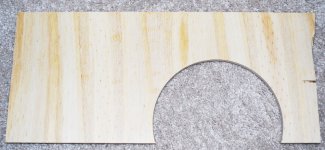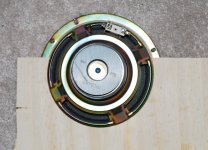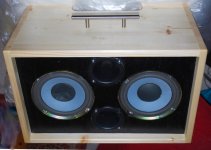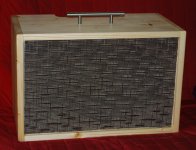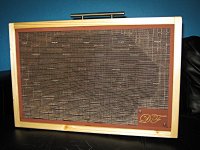If the ridged area at the edge of the cone can physically touch the wood at high volume levels, it could create a sound like a kazoo....been there, made that, fixed it with a wood file. It could also be the sliding back rattling. Remove it and test again.
I have one of those Jensen MOD 5's. It's not in a cabinet right now, but it was. The old cabinet looks to be about the same size as yours, but never had a back. It was used to test amp designs for the Hundred Buck Amp Challenge several years ago. It was a simple box made with sheetrock screws and scrap wood, and got tossed when I had to move everything I owned twice for a total of 1200 miles. I kept the speaker for a future project. Seen here eating about 25 watts of overdriven full metal racket. It sounded pretty good for lead guitar, but as expected you aren't going to get big bass, nor do you really want it if you play in the distortion region (sounds muddy).
Very nice. Your round cut out is, well, round.
Having played a bit for the last couple of days, I think the kazoo sound is just the pronounced mids / top end not playing nice with my 2203 input, higher gain settings. Clean / crunch sounds with the October input are surprisingly nice. With the speaker at head height, and sitting off-axis, it's perfectly OK for playing along with youtube.
And, even more surprisingly to me, there is a good-enough bass sound available - I experimented with closing the back as best I could (not entirely air-tight) and also adding stuffing. I'm tempted to leave it with that combination for a while...
I'm not sure what George's secret is (I suspect a router).Very nice. Your round cut out is, well, round.
For myself, I've never managed to get a proper circular cut out with a jigsaw. But once I got my hands on a router, and made a very simple plywood circle-cutting jig for it, speaker cut-outs became straightforward. I just set the router depth to make repeated shallow cuts, and keep making passes until the hole is all the way through.
The actual circle-cutting jig is simplicity itself: a strip of plywood with four screw-holes to mount to the face of the router, pivoting on a nail pushed through one more hole spaced at the right distance.
At my first engineering job in the late 1990s, we had a small machine-shop in the basement, complete with an end-mill, with a turntable attachment. That was the bee knees: clamp a piece of MDF on the turntable, start the end-mill, raise the turntable with one feed screw, turn it with another, and there you go, perfect speaker cutout!
I've never tried to make a circle-cutting jig for a jigsaw, but I suppose that's also a possibility. My jigsaw doesn't have any convenient mounting holes, though, while every router I've seen has them.
For your present project, though, a perfectly engineered speaker cabinet almost seems wrong! 🙂
-Gnobuddy
I'm not sure what George's secret is (I suspect a router)…..I've never managed to get a proper circular cut out with a jigsaw.
No, I cut the hole with a jig saw. I don't remember how it looked, but I'm sure it was on par with yours. I cut the hole about 1/8 inch too small, then made it pretty with a spindle sander. We had a large Jet spindle sander in shop class in Florida. I made that box in about an hour with a jig saw, a table saw, and the spindle sander. One of the women in the class practiced on it with her new belt sander.
I got one of these. It was $129 when I got it 2 years ago. It works good enough for anything I do.
Amazon.com: Shop Fox W1831 1/2 HP Single Phase Oscillating Spindle Sander: Home Improvement
There you go, more than one way to ski - err - pet a cat!...made it pretty with a spindle sander.
Routers scare me (and they are famous for doing terrible things to human hands when they get the chance). But they do let you make nice cutouts, even recessed ones for front-mount speakers.
These pics are from an amp I built in late 2017 as a gift for a friend. The pics go from first test cutout in a scrap of plywood to finished combo cab.
-Gnobuddy
Attachments
Just a quick FWIW, the 12" guitar speaker I use has Fs a little over 100Hz, and a Qts of over 0.8.
It's not flat into the bass, but that isn't really a requirement for guitar IMO.
If it was mine, I'd probably try the back mostly in place, with a slot still open around 1" wide. Add a touch of stuffing towards the other side of the enclosure.
Chris
It's not flat into the bass, but that isn't really a requirement for guitar IMO.
If it was mine, I'd probably try the back mostly in place, with a slot still open around 1" wide. Add a touch of stuffing towards the other side of the enclosure.
Chris
Just a quick FWIW, the 12" guitar speaker I use has Fs a little over 100Hz, and a Qts of over 0.8.
It's not flat into the bass, but that isn't really a requirement for guitar IMO.
If it was mine, I'd probably try the back mostly in place, with a slot still open around 1" wide. Add a touch of stuffing towards the other side of the enclosure.
Chris
The cab I use is 4 x 10" bass cab retrofitted with guitar speakers, 4" port at the front.
It's far too nasal and heavy without the port blocked, but sounds spot on as closed box.
On the other hand I have a small 10W Kustom practice amp with a 5 or 6" driver in it. It sounds ok, naturally not voiced the same as a 10 or 12", a bit buzzy perhaps, presence peak wayyy higher up.
Now that only sounds any good as is, OB.
I'm surprised the OP liked the set up closed box. It must be a radically different driver to the one in my cheap Kustom.
Routers scare me (and they are famous for doing terrible things to human hands when they get the chance).
I can't do much with a hand held router except make scrap wood. My hands shake too much. I wandered into a tool store in an outlet mall one day and walked out with a router table for $79. The router is securely fastened in a base with the bit facing up. There is a fence to run the material along somewhat like a table saw. It reduces the fear factor, but they can eat fingers like a table saw, and still wont make circles.
Lacking a spindle sander, a similar effect can be done with a sanding spindle in a hand held drill. This required steady hands and patience.....I lack in both departments.
That already-high Qts value of 0.8 is only achieved if the speaker is driven from an amp with zero (or very low) output impedance....the 12" guitar speaker I use has Fs a little over 100Hz, and a Qts of over 0.8.
Most valve guitar amps have pentode or beam tetrode output devices, which have very high output impedances. Even allowing for the output transformer (which steps down voltage and steps down output impedance at the same time), it seems most small (say 5 W - 40 W) guitar amps have output impedances in the general ballpark of 15 ohms to 50 ohms. (A number of measurements made by two or three people on several different amps all ended up in roughly this region.)
Even the lowest of these (15 ohms) is high enough to eliminate most of the magnetic damping in the loudspeaker - the voice coil generates back-emf as usual, but there is too much impedance in the circuit, so not much damping current can flow. The result is that the mechanical Q of the speaker resonance rises from Qts towards Qms (mechanical damping only.)
For all the speakers whose data I've looked at, Qms is usually much higher than Qts. It seems to range in value from around 3 to around 10.
Even the lowest of those values (3) creates quite a big bass "hump" at the speaker resonance. It would be quite intolerable for Hi-Fi, but seems to be just fine for guitar.
In short, when a guitar speaker is connected to a small valve guitar amp, Qts becomes unimportant, and the actual speaker Q is usually quite a lot higher.
This should produce elevated and "woofy" bass, which may be one reason why speakers of the 1940s often just had a baffle, rather than a box. Leonidas Fender opted to do the same and use open-back "cabs" on his guitar amps - the limited bass response of the cab (which is really just a baffle with the edges folded at 90 degrees) might be helping to EQ away the woofy deep bass from the high-Q speaker resonance.
-Gnobuddy
> Qms is usually much higher than Qts.
Better be. Low Qes is "good", efficiency. Makes sound. Low Qms is "bad", friction in the spider and surround. Does not make sound.
Qes is quoted for zero-Z drive but can be computed for any source impedance. Look at the speaker DCR. For "8 Ohms", typically 6 Ohms. Say quoted Qes is 0.8. Add an amplifier of 6 Ohms. Now effective Qes is 1.6. A 12 Ohm amp gives Qes of 2.4.
Qms is, as you say, 3 to 10.
Qts is figured like resistors. Ignoring some stray effects, taking Qes=2.4 and Qms=5, 1/(1/2.4+1/5) makes Qts 1.62.
This leads to a 4dB peak at resonance. Not hi-fi.
What most classic cabinets do, since they also had to ventilate a hot amplifier, is leave the back open. This causes (as you say) a 6dB/oct fall below the point that the baffle is effective. For some typical values, the drop due to loss of baffling tends to compensate the rise due to low damping. IMHO this is why some old Fender Twins are so brutally effective: not only reasonably flat output to the lowest guitar note, but improved projection due to dipole action, and in a minimal size for the power capability.
Better be. Low Qes is "good", efficiency. Makes sound. Low Qms is "bad", friction in the spider and surround. Does not make sound.
Qes is quoted for zero-Z drive but can be computed for any source impedance. Look at the speaker DCR. For "8 Ohms", typically 6 Ohms. Say quoted Qes is 0.8. Add an amplifier of 6 Ohms. Now effective Qes is 1.6. A 12 Ohm amp gives Qes of 2.4.
Qms is, as you say, 3 to 10.
Qts is figured like resistors. Ignoring some stray effects, taking Qes=2.4 and Qms=5, 1/(1/2.4+1/5) makes Qts 1.62.
This leads to a 4dB peak at resonance. Not hi-fi.
What most classic cabinets do, since they also had to ventilate a hot amplifier, is leave the back open. This causes (as you say) a 6dB/oct fall below the point that the baffle is effective. For some typical values, the drop due to loss of baffling tends to compensate the rise due to low damping. IMHO this is why some old Fender Twins are so brutally effective: not only reasonably flat output to the lowest guitar note, but improved projection due to dipole action, and in a minimal size for the power capability.
Happy workers day! Gnobuddy Sorry Im not quite awake yet. Today is a hollyday for most workers in Denmark. Would you say that a guitarcabinet, should ideally have a higher impedance in its whole register, than the outputimpedance of the amp?
Cheers!
Cheers!
No wonder Denmark is the happiest country on earth! 🙂Today is a holiday for most workers in Denmark.
I don't think we need to change anything. After all, we've had several decades of great guitar tone using guitar amps with output impedance much higher than the speaker's impedance (DC resistance, to be more accurate, as PRR pointed out.)Would you say that a guitar cabinet, should ideally have a higher impedance in its whole register, than the output impedance of the amp?
I think it's just one more thing for us DIY guitar amp types to be aware of - one more way in which guitar amps are quite different from Hi-Fi amps.
Aside from telling us to pretty much chuck Thiele/Small cab design out of the window for valve guitar amps, I think the other significant consequence of high output impedance is that it affects speaker attenuator design: a good speaker attenuator should maintain the high output impedance of the amp, otherwise, it will change the sound as the speaker volume is dialed down. But many of the people who designed and built guitar speaker attenuators don't seem to have realized this - most guitar attenuator designs I have seen have low output impedance!
(J.M. Fahey, who is a diyAudio member, is one of the people who did it right. His "3 AM attenuator" has a high output impedance.)
Also worth mentioning: at least some manufacturers of solid-state guitar amps go to some trouble to give their amplifiers high output impedance, to mimic the behaviour a valve guitar amp produces from the guitar speaker. There was a recent diyAudio thread about a very unusual VOX solid-state guitar power amp design, that seems to have been designed from the ground up with one goal in mind, i.e., to have a high output impedance.
-Gnobuddy
I stumbled across this today: How to Cut a Perfect Circle with a Jigsaw | Man Made DIY | Crafts for Men
The clever part is using double-sided carpet tape to stick the home-made circle-cutting jig to the bottom of the jigsaw.
-Gnobuddy
The clever part is using double-sided carpet tape to stick the home-made circle-cutting jig to the bottom of the jigsaw.
-Gnobuddy
...chuck Thiele/Small cab design out of the window for valve guitar amps....
Disagree. What the T/S fad did was get manufacturers to publish "complete" specs for their speakers (below break-up). These numbers can be adjusted for non-zero source and arbitrary baffles by simple acoustic theory. This is somewhat quicker than actually understanding speakers (a lost art) or buying dozens of samples to try.
Fed from these high source impedance amps, the speaker Q on resonance is always far too high to design any kind of enclosure around. Yes, you can calculate exactly how too-high that Q is, but there is nothing useful to be done with that result. It is too high for a sealed box, much too high for a ported box, and therefore there is no Thiele/Small enclosure design left to do.These numbers can be adjusted for non-zero source and arbitrary baffles by simple acoustic theory.
J.M. Fahey pointed out in another thread that a classic VOX amp had a bass corner frequency of 600 Hz; astonishingly, everything below that was rolled off.
I hunted online for spectrograms of plucked guitar strings a while ago, and found very little energy below 166 Hz in any of them (2nd harmonic of an open sixth-string low "E"). Often the dominant frequency was near 250 Hz (3rd harmonic of the low E.) In some cases, the dominant frequency was the 4th harmonic, up around 330 Hz.
A while ago I tinkered a bit with LTSpice's ability to generate WAV files from voltage waveforms. I set up a voltage source to produce a damped sine wave, very crudely simulating a plucked guitar string (it sound more like a struck bell), and converted that to a WAV file I could listen to.
Set to 82.4 Hz (guitar low E in standard tuning), it sounded far too "beefy" and deep, like a bass guitar, not a regular tenor guitar. I had to set the sine to 164.8 Hz to get it to sound even a little like a real guitar low "E".
The point of all this? I think a big part of the reason why electric guitarists aren't bothered by a big woofy speaker resonance around 80 - 100 Hz, is simply that the instrument doesn't actually put out much signal down at those frequencies. Our ears and brain study the harmonic series and conclude that the string is tuned to 82 Hz, yes, but there just isn't much energy at that fundamental frequency.
-Gnobuddy
....speaker Q on resonance is always far too high to design any kind of enclosure around. ...there is no Thiele/Small enclosure design...
....I think a big part of the reason why electric guitarists aren't bothered by a big woofy speaker resonance around 80 - 100 Hz, is simply that the instrument doesn't actually put out much signal down at those frequencies.....
2) If we really don't want 82Hz, why don't we use smaller speakers? (Yes, for efficiency, output, and source-size effects on the ear.... but we could design a 6" 300Hz horn far more efficient and much easier to carry.)
I think we do need response well below 150Hz (depending what we paid) to have "balls". In modern pop-music this is less essential because the bassist is all over 50Hz-250Hz, but a no-bass guitar speaker will be gut-less. At the extreme a Full Stack can pound your chest (when the bassist takes a rest).
1) Theile's paper hooks into the entirety of filter theory. It is "possible" to design a low-Q filter with one hi-Q element, though that forces some unhappy compromise.
However a mid-high impedance amplifier is not always a high-Q result. Many Fender classics have just enough NFB to put Zout near speaker nominal impedance; speaker Q doubles. And aside from the cheap junk often put in factory amplifiers there are the Theater type speakers with Fo near 45Hz and Q<0.5. When teamed with such an amplifier you get a slightly declining bottom, also excess excursion. A stiffer spider puts Fo nearer 80Hz and Q near unity, the Instrument speaker (good, not cheap). JBL E-120, EV MI 12L, etc.
A story: I played w a guitarist who was invited onstage with Led Zeppelin. He said that the high e string felt like a firm kick in the back. When we played he loaded the basement with his one12 inch Session amp. Not low bass but we could feel it. He had to play loud cause he was so deaf.
Btw Ive been given a 12inch Steelphon driver when I pick it up. Will ask advise. Actually I have 4 norvegian 6 inch fullranges from the 50ies I found them on a radiostation 15 years ago so I guess I ought to prioritize that project first
We are well into personal opinion territory, which can be fun, but won't necessarily help us to learn anything. However, since we're gathered around the water cooler already, I'll throw in my two cents. 🙂
And yet, when I play mix engineer at home with one of my own compositions, a 300 Hz high-pass is not unusual for the guitar parts...to my ears, they "sit in the mix" much better that way, and there is less "mud" in the overall sound. Solo that high-passed guitar track, and it sounds thin. In the mix, it's better. Just as you said, the drums and bass are already occupying the spectrum below 300 Hz, so keeping the guitar above that makes all three instruments sound better.
As for e-guitar through a 150 Hz high-pass, the effect of the filter can be heard, sure, but to my ears it often makes an e-guitar sound better, taking away the boomyness and improving clarity. We are, of course, firmly on subjective territory here, and it is entirely likely that you and I might not share that opinion.
But how can one do this combined high-Q resonance /very low-Q resonance filter design with a loudspeaker + enclosure? In a normal speaker system, the loudspeaker provides virtually all the damping at the fundamental speaker resonance frequency. Putting the speaker in a sealed box raises the Q, because we've added more spring without adding more damping. Putting the speaker in a ported box also raises the Q, because we've added more mass (in the port), without adding more damping; the speaker damping has to control the air in the port as well as the speaker's own moving mass (Mms). Adding amplifier source resistance raises the system Q even more.
So how can we lower the already too-high speaker system Q back down? We'd have to add additional damping, not provided by the speaker, not provided by the enclosure itself. Something like stapling a pillow over the loudspeaker opening, or making a transmission line enclosure stuffed with foam or acoustic wool, or possibly a vented enclosure with a large port stuffed with foam. Maybe an open-back speaker cab where the "open" back is actually a block of foam, so that air viscosity provides mechanical damping as the air flows back and forth through it.
The pillow solution has obvious problems. The others might work out - but in any case, we are no longer in traditional Thiele-Small enclosure design territory as laid out in their seminal paper, which uses the speaker itself to provide the only significant damping in the speaker+box system.
I do think the idea is interesting. After some experimenting, I threw a $4 Walmart pillow into the last sealed guitar speaker cab I built, where it removed some audible midrange boxiness. But this was more a case of damping internal acoustic resonance modes of the cab, rather than damping the speaker's own fundamental resonance. The latter would require a more sophisticated approach.
At any rate, with a decent measurement microphone and some PC sound-card measurement software, this might be an interesting project to explore.
-Gnobuddy
I agree with you that we can most definitely hear a change in sound (and it's not subtle) when an electric guitar is fed through a 300 Hz high-pass filter. After all, that's two full octaves above the 6th-string low E....300Hz...150Hz...
And yet, when I play mix engineer at home with one of my own compositions, a 300 Hz high-pass is not unusual for the guitar parts...to my ears, they "sit in the mix" much better that way, and there is less "mud" in the overall sound. Solo that high-passed guitar track, and it sounds thin. In the mix, it's better. Just as you said, the drums and bass are already occupying the spectrum below 300 Hz, so keeping the guitar above that makes all three instruments sound better.
As for e-guitar through a 150 Hz high-pass, the effect of the filter can be heard, sure, but to my ears it often makes an e-guitar sound better, taking away the boomyness and improving clarity. We are, of course, firmly on subjective territory here, and it is entirely likely that you and I might not share that opinion.
Certainly! I've seen this done in "classical" 3rd and higher order analogue filters. Also, a Marshall speaker-emulator filter I studied in LTSpice not long ago is another example of this - there is a filter stage with a too-high bass resonance Q, preceded by a very low Q high-pass filter that removes much of the bass peak, so that the combination has a manageable Q, roughly emulating the bass hump in a Marshall 4x12 cab.It is "possible" to design a low-Q filter with one hi-Q element, though that forces some unhappy compromise.
But how can one do this combined high-Q resonance /very low-Q resonance filter design with a loudspeaker + enclosure? In a normal speaker system, the loudspeaker provides virtually all the damping at the fundamental speaker resonance frequency. Putting the speaker in a sealed box raises the Q, because we've added more spring without adding more damping. Putting the speaker in a ported box also raises the Q, because we've added more mass (in the port), without adding more damping; the speaker damping has to control the air in the port as well as the speaker's own moving mass (Mms). Adding amplifier source resistance raises the system Q even more.
So how can we lower the already too-high speaker system Q back down? We'd have to add additional damping, not provided by the speaker, not provided by the enclosure itself. Something like stapling a pillow over the loudspeaker opening, or making a transmission line enclosure stuffed with foam or acoustic wool, or possibly a vented enclosure with a large port stuffed with foam. Maybe an open-back speaker cab where the "open" back is actually a block of foam, so that air viscosity provides mechanical damping as the air flows back and forth through it.
The pillow solution has obvious problems. The others might work out - but in any case, we are no longer in traditional Thiele-Small enclosure design territory as laid out in their seminal paper, which uses the speaker itself to provide the only significant damping in the speaker+box system.
I do think the idea is interesting. After some experimenting, I threw a $4 Walmart pillow into the last sealed guitar speaker cab I built, where it removed some audible midrange boxiness. But this was more a case of damping internal acoustic resonance modes of the cab, rather than damping the speaker's own fundamental resonance. The latter would require a more sophisticated approach.
At any rate, with a decent measurement microphone and some PC sound-card measurement software, this might be an interesting project to explore.
-Gnobuddy
That's really sad. A deaf musician is like a blind painter or a ballerina who lost her feet in a car accident....the high e string felt like a firm kick in the back...he was so deaf.
It's particularly sad when the musician has caused his own deafness. That's like a painter who blinds himself, or a ballerina who chops off her own feet. 🙁
-Gnobuddy
Sorry! He was still far from totally deaf. He could follow our conversation. It was about 25 years ago. I would have objected if the band didnt fade out for other reasons. I was the singer and had many dicussions with guitarists and drummers. Especially cymbals bothered me in the begining, but for obvious reasons gradually less as my hearing got damaged at high frequensies. For many years music sounded dull to me, but I feel its much better now
- Status
- Not open for further replies.
- Home
- Live Sound
- Instruments and Amps
- Cabinet design for 5" driver - guitar use
